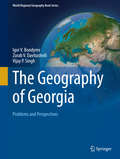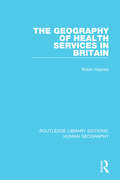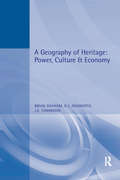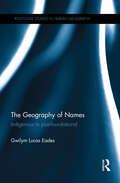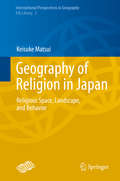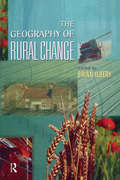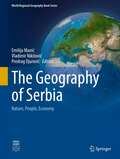- Table View
- List View
The Geography of Climate Change Adaptation in Urban Africa
by Patrick Brandful Cobbinah Michael AddaneyThis book takes a comprehensive look at several cases of climate change adaptation responses across various sectors and geographical areas in urban Africa and places them within a solid theoretical context. Each chapter is a state-of-the-art overview of a significant topic on climate change adaptation in urban Africa and is written by a leading expert in the field. In addition to the focus on the geography of urban adaptation to climate change in Africa, this collection offers a broader perspective by blending the use of case studies and theory based research. It examines transformations in climate change adaptation and its future orientation from the perspectives of urban planners, political economists, environmentalists, ecologists, economists and geographers, thereby addressing the challenges facing African cities adaptation responses from all angles. Providing up-to-date and authoritative contributions covering the key aspects of climate change adaptation in urban Africa, this book will be of great interest to policymakers, practitioners, scholars and students of geography, urban development and management, environmental science and policy, disaster management, as well as those in the field of urban planning.
The Geography of Competition: Firms, Prices, and Localization
by John R. MironThis book provides a comprehensive, up-to-date, and expert synthesis of location theory. What are the impacts of a firm’s geographic location on the locations of customers, suppliers, and competitors in a market economy? How, when, and why does this result in the clustering of firms in space? When and how is society made better or worse off as a result? This book uses dozens of locational models to address aspects of these three questions. Classical location problems considered include Greenhut-Manne, Hitchcock-Koopmans, and Weber-Launhardt. The book reinterprets competitive location theory, focusing on the linkages between Walrasian price equilibrium and the localization of firms. It also demonstrates that competitive location theory offers diverse ideas about the nature of market equilibrium in geographic space and its implications for a broad range of public policies, including free trade, industrial policy, regional development, and investment in infrastructure. With an extensive bibliography and fresh, interdisciplinary approach, the book will be an invaluable reference for academics and researchers with an interest in regional science, economic geography, and urban planning, as well as policy advisors, urban planners, and consultants.
The Geography of Contemporary China: The Impact of Deng Xiaoping's Decade
by Terry Cannon Alan JenkinsDeng Xiaoping's rule has seen fundamental economic change in China. This book considers the impact of these years on China's physical environment, as well as its people, industry, agriculture and trade. It also assesses the contribution of a decade of Chinese politics towards geopolitics. The book provides an introduction to Communist China, setting its spatial and environmental themes in the historical, political and economic framework so crucial to a proper understanding of this country and the fifth of the world's population it contains. It is particularly suited to courses on China, its geography and development strategy. After the bloody events of Tiananmen Square in June 1989 China's geopolitics will continue to hold the world's attention. With this in view the book also provides guides to further reading.
The Geography of Contemporary China: The Impact of Deng Xiaoping's Decade
by Terry Cannon Alan JenkinsDeng Xiaoping's rule has seen fundamental economic change in China. This book considers the impact of these years on China's physical environment, as well as its people, industry, agriculture and trade. It also assesses the contribution of a decade of Chinese politics towards geopolitics. The book provides an introduction to Communist China, setting its spatial and environmental themes in the historical, political and economic framework so crucial to a proper understanding of this country and the fifth of the world's population it contains. It is particularly suited to courses on China, its geography and development strategy. After the bloody events of Tiananmen Square in June 1989 China's geopolitics will continue to hold the world's attention. With this in view the book also provides guides to further reading.
The Geography of Contemporary China (World Regional Geography Book Series)
by Jing’ai Wang Shunlin Liang Peijun ShiThis textbook provides a comprehensive and very detailed insight into Chinese Contemporary Geography in English. It documents the geographical issues associated with China's rapid growth. Since initiating the reforms and open policy, China has achieved tremendous success. China's rapid growth is now a driving force in the global economy and is achieving unprecedented rates of poverty reduction. However, China also faces a number of sustainability and emerging challenges associated with rapid growth such as growing regional disparities in terms of per capita income and social-economic development, sustainable resource development, and issues related to regional and global economic integration. In addition, rapid economic growth has also brought about major challenges such as resource shortages, ecological and environmental destruction, land degradation and frequent disasters. This book presents the authors’ reflections. This lavishly illustrated book covers physical geography, history, and economic and political systems of the world's most populous country. The major focus is on geographical issues in China's contemporary development: agriculture, population, urbanization, resource and energy, and environment. The lead author of the book has taught relevant courses in China for three decades, and authored and edited multiple textbooks for Chinese students. This book will appeal to undergraduate students of geography and related disciplines with a regional focus on China and to the general reader who wants to learn different geographical aspects of modern China with little academic background in geography.
The Geography of Environmental Crime: Conservation, Wildlife Crime and Environmental Activism (Palgrave Studies in Green Criminology)
by Matthew Hall Gary R. R. Potter Angus NurseThis book critically examines both theory and practice around conservation crimes. It engages with the full complexity of environmental crimes and different responses to them, including: poaching, conservation as a response to wildlife crime, forest degradation, environmental activism, and the application of scientific and situational crime prevention techniques as preventative tools to deal with green crime. Through the contributions of experts from both the social and ecological sciences, the book deals with theoretical and practical considerations that impact on the effectiveness of contemporary environmental criminal justice. It discusses the social construction of green crimes and the varied ways in which poaching and other conservation crimes are perceived, operate and are ideologically driven, as well as practical issues in environmental criminal justice. With contributions based in varied ideological perspectives and drawn from a range of academic disciplines, this volume provides a platform for scholars to debate new ideas about environmental law enforcement, policy, and crime prevention, detection and punishment.
The Geography of Georgia: Problems and Perspectives (World Regional Geography Book Series)
by Igor V. Bondyrev Zurab V. Davitashvili Vijay P. SinghThis book discusses the political and economic history and geography of Georgia, the problems it has faced, and how it has overcome and is still overcoming them. In most countries, at the end of the 20th century the successful resolution of social-economic, political, demographic and ecological problems was largely dependent on effectively protecting the population and economic assets from natural disasters and on ensuring conditions for their sustainable development. These problems are most acute in mountainous regions like Georgia, where the unplanned development of natural ecosystems has had drastic consequences. It is therefore necessary to understand not only the probability of changing conditions (natural as well as political and demographic), but also the probability of the resulting economic losses. The book is divided into four sections; historical and political geography, geological processes, ecological processes and developmental geography. In the historical and political geography section the authors present a detailed discussion on ancient history, historical and political geography, ethnic groups and religions, demographics and socio-cultural geography. The geological processes section contains information on geology, geodynamical processes, glacial and periglacial processes. The ecological processes section examines a variety of landscapes and ecosystems, aspects of deforestation, reforestation and desertification along with anthropogenic impacts on the environment. The developmental geography section looks at different economies, natural resources, sustainable development and climate change.
The Geography of Greece: Managing Crises and Building Resilience (World Regional Geography Book Series)
by Régis Darques George Sidiropoulos Kostas KalabokidisDuring the last few years, Greece has become a subject of increasing attention worldwide. Once praised for its ability to innovate and reform during the EU integration process, applauded for its remarkable job in managing the 2004 Olympics, the country fell into a financial crisis of unprecedented magnitude in 2008. Much has been said on this matter, and amid the morass of information a staggering number of untruths have been disseminated.In fact, the challenges of vulnerability and the paradigms of adaptation go way beyond finance and economy in Greece. Mega-fires, earthquakes, landslides and floods, migrations, sociopolitical upheavals, and armed conflicts generate emergency situations repeatedly. Because of its bridging role between natural and social sciences, geography can provide insights into the entire breadth of hazardous and chaotic events driving adaptation and change. Against all these threats, Greece has developed an enhanced resilience capacity. The purpose of this book is to help unravel the complexities of a fascinating country beyond clichés.This book is intended for students, researchers, scholars, and engineers interested in geography, land planning, urban studies, and environmental management. The crises issue intended as a guideline allows widening the audience to include the media, governmental and non-governmental agencies, and the public at large.
The Geography of Health Services in Britain. (Routledge Library Editions: Human Geography)
by Robin HaynesThis book is about geographical variation in the organisation, provision and use of health services in Britain. Its main theme is that neither the quantity nor the quality of health care provided by the National Health Service (NHS) is uniform from place to place. Chapters discuss and evaluate: The reorganisation of the NHS in the years up to 1987 The relationships between the need for health care and the supply of health services The redistribution of health service resources geographically The distribution of doctors, dentists, community nurses and hospitals across the UK Access to health services The distribution of both private health facilities and social welfare services and their effect on the NHS.
The Geography of Health Services in Britain. (Routledge Library Editions: Human Geography #9)
by Robin HaynesThis book is about geographical variation in the organisation, provision and use of health services in Britain. Its main theme is that neither the quantity nor the quality of health care provided by the National Health Service (NHS) is uniform from place to place. Chapters discuss and evaluate: The reorganisation of the NHS in the years up to 1987 The relationships between the need for health care and the supply of health services The redistribution of health service resources geographically The distribution of doctors, dentists, community nurses and hospitals across the UK Access to health services The distribution of both private health facilities and social welfare services and their effect on the NHS.
A Geography of Heritage
by Brian Graham Greg Ashworth John TunbridgeThe concept of heritage relates to the ways in which contemporary society uses the past as a social, political or economic resource. However, heritage is open to interpretation and its value may be perceived from differing perspectives - often reflecting divisions in society. Moreover, the schism between the cultural and economic uses of heritage also gives rise to potential conflicts of interest. Examining these issues in depth, this book is the first sustained attempt to integrate the study of heritage into contemporary human geography. It is structured around three themes: the diversity of use and consumption of heritage as a multi-sold cultural and economic resource; the conflicts and tensions arising from this multiplicity of uses, producers and consumers; and the relationship between heritage and identity at a variety of scales.
A Geography of Heritage: Power, Culture And Economy (A\hodder Arnold Publication)
by Brian Graham Greg Ashworth John TunbridgeThe concept of heritage relates to the ways in which contemporary society uses the past as a social, political or economic resource. However, heritage is open to interpretation and its value may be perceived from differing perspectives - often reflecting divisions in society. Moreover, the schism between the cultural and economic uses of heritage also gives rise to potential conflicts of interest. Examining these issues in depth, this book is the first sustained attempt to integrate the study of heritage into contemporary human geography. It is structured around three themes: the diversity of use and consumption of heritage as a multi-sold cultural and economic resource; the conflicts and tensions arising from this multiplicity of uses, producers and consumers; and the relationship between heritage and identity at a variety of scales.
The Geography of Innovation (Economics of Science, Technology and Innovation #2)
by M.P. FeldmanThis book offers a geographic dimension to the study of innovation and product commercialization. Building on the literature in economics and geography, this book demonstrates that product innovation clusters spatially in regions which provide concentrations of the knowledge needed for the commercialization process. The book develops a conceptual model which links the location of new product innovations to the sources of these knowledge inputs. The geographic concentration of this knowledge fonns a technological infrastructure which promotes infonnation transfers, and lowers the risks and the costs of engaging in innovative activity. Empirical estimation confinns that the location of product innovation is related to the underlying technological infrastructure, and that the location of the knowledge inputs are mutually reinforcing in defining a region's competitive advantage. The book concludes by considering the policy implications of these fmdings for both private finns and state governments. This work is intended for academics, policy practitioners and students in the fields of innovation and technological change, geography and regional science, and economic development. This work is part of a larger research effort to understand why the location of innovative activity varies spatially, specifically the externalities and increasing returns which accrue to location. xi Acknowledgements This work has benefitted greatly from discussions with friends and colleagues. I wish to specifically note the contribution of Mark Kamlet, Wes Cohen, Richard Florida, Zoltan Acs and David Audretsch. I would like to thank Gail Cohen Shaivitz for her dedication in editing the final manuscript.
The Geography of Names: Indigenous to post-foundational (Routledge Studies in Human Geography)
by Gwilym Lucas EadesThis book examines geographical names, place-names, and toponymy from philosophical and cultural evolutionary perspectives. Geographical name-tracking-networks (Geo-NTNs) are posited as tools for tracking names through time and across space, and for making sense of how names evolve both temporally and spatially. Examples from North and South American indigenous groups, the Canadian arctic, Wales, England, and the Middle East are brought into a theoretical framework for making sense of aspects of place-naming practices, beliefs, and systems. New geographical tools such as geographic information systems (GIS) and global positioning systems (GPS) are demonstrated to be important in the production and maintenance of robust networks for keeping names and their associated meanings viable in a rapidly changing world where place-naming is being taken up increasingly in social media and other new mapping platforms. The Geography of Names makes the case that geographical names are transmitted memetically (i.e. as cultural units, or memes) through what Saul Kripke called communication chains. Combining insights from Kripke with views of later Wittgenstein on language and names as being inherently spatial, the present work advances theories of both these thinkers into an explicitly geographical inquiry that advances philosophical and practical aspects of naming, language, and mapping.
The Geography of Names: Indigenous to post-foundational (Routledge Studies in Human Geography)
by Gwilym Lucas EadesThis book examines geographical names, place-names, and toponymy from philosophical and cultural evolutionary perspectives. Geographical name-tracking-networks (Geo-NTNs) are posited as tools for tracking names through time and across space, and for making sense of how names evolve both temporally and spatially. Examples from North and South American indigenous groups, the Canadian arctic, Wales, England, and the Middle East are brought into a theoretical framework for making sense of aspects of place-naming practices, beliefs, and systems. New geographical tools such as geographic information systems (GIS) and global positioning systems (GPS) are demonstrated to be important in the production and maintenance of robust networks for keeping names and their associated meanings viable in a rapidly changing world where place-naming is being taken up increasingly in social media and other new mapping platforms. The Geography of Names makes the case that geographical names are transmitted memetically (i.e. as cultural units, or memes) through what Saul Kripke called communication chains. Combining insights from Kripke with views of later Wittgenstein on language and names as being inherently spatial, the present work advances theories of both these thinkers into an explicitly geographical inquiry that advances philosophical and practical aspects of naming, language, and mapping.
The Geography of Networks and R&D Collaborations (Advances in Spatial Science)
by Thomas ScherngellThe geography of networks and R&D collaborations, in particular the spatial dimension of interactions between organisations performing joint R&D, have attracted a burst of attention in the last decade, both in the scientific study of the networks and in the policy sector. The volume is intended to bring together a selection of articles providing novel theoretical and empirical insights into the geographical dynamics of such networks and R&D collaborations, using new, systematic data sources and employing cutting-edge spatial analysis and spatial econometric techniques. It comprises a section on analytic advances and methodology and two thematic sections on structure and spatial characteristics of R&D networks and the impact of R&D networks and policy implications. The edited volume provides a collection of high-level research contributions with an aim to contribute to the recent debate in economic geography and regional science on how the structure of formal and informal networks modifies and influences the spatial and temporal diffusion of knowledge.
Geography of Order and Chaos in Mechanics: Investigations of Quasi-Integrable Systems with Analytical, Numerical, and Graphical Tools (Progress in Mathematical Physics #64)
by Bruno CordaniThis original monograph aims to explore the dynamics in the particular but very important and significant case of quasi-integrable Hamiltonian systems, or integrable systems slightly perturbed by other forces. With both analytic and numerical methods, the book studies several of these systems—including for example the hydrogen atom or the solar system, with the associated Arnold web—through modern tools such as the frequency modified fourier transform, wavelets, and the frequency modulation indicator. Meanwhile, it draws heavily on the more standard KAM and Nekhoroshev theorems. Geography of Order and Chaos in Mechanics will be a valuable resource for professional researchers and certain advanced undergraduate students in mathematics and physics, but mostly will be an exceptional reference for Ph.D. students with an interest in perturbation theory.
Geography of Order and Chaos in Mechanics: Investigations of Quasi-Integrable Systems with Analytical, Numerical, and Graphical Tools (Progress in Mathematical Physics #64)
by Bruno CordaniThis monograph explores the dynamics in the particular but very important and significant case of quasi-integrable Hamiltonian systems, or integrable systems slightly perturbed by other forces. With both analytic and numerical methods, the book studies several of these systems - such as the hydrogen atom and the solar system, with the associated Arnold web - through modern tools such as the frequency-modified Fourier transform, wavelets, and the frequency-modulation indicator. Meanwhile, it draws heavily on the more standard KAM and Nekhoroshev theorems. Geography of Order and Chaos in Mechanics contains many figures that illuminate its concepts in novel ways, but perhaps its most useful feature is its inclusion of software to reproduce the various numerical experiments. The graphical user interfaces of five supplied MATLAB programs allows readers without any knowledge of computer programming to visualize and experiment with the distribution of order, chaos and resonances in various Hamiltonian systems. This monograph will be a valuable resource for professional researchers and certain advanced undergraduate students in mathematics and physics, as well as an exceptional reference for PhD students with an interest in perturbation theory. The Second Edition includes a new chapter on theoretical and numerical results in the study of the solar system's (in)stability obtained since publication of the First Edition, clarifying the topological mechanism that causes the sudden increase in Mercury's eccentricity. An updated version of the companion software is also provided, which contains new features and better Graphical User Interfaces. Thanks to the compiled versions, all the software can be used even if the user does not have access to a MATLAB installation.
Geography of Religion in Japan: Religious Space, Landscape, and Behavior (International Perspectives in Geography #2)
by Keisuke MatsuiThis book discusses modern aspects of Japanese religion in terms of cultural geography. To understand the function of religion, it is essential to examine it in the context of local societies. One of the distinguishing characteristics of Japanese religion is its diversity; indeed, it is often remarked that “Japan is a museum of religions.” In this work, the author clarifies some geographical aspects of the complex situation of Japanese religion. Chapter 1 discusses the trend of geographical studies of religion in Japan, of which four types can be identified. Chapter 2 focuses on certain characteristics of Japanese religious traditions by discussing tree worship and the landscape of sacred places. Chapter 3 clarifies regional divisions in the catchment areas of Japanese Shintoism by analyzing the distribution of certain types of believers. The author discusses two case studies: the Kasama Inari Shrine and the Kanamura Shrine. Chapter 4 discusses some modern aspects of sacred places and tourism through two case studies. The first part of the chapter focuses on changes in the types of businesses at the Omotesando of the Naritasan Shinshoji-Monzenmachi, and the following sections examine the revitalization of the local community through the promotion of religious tourism.
The Geography of Rural Change
by Brian IlberyThe Geography of Rural Change provides a thorough examination of the processes and outcomes of rural change as a result of a period of major restructuring in developed market economies. After outlining the main dimensions of rural change, the book progresses from a discussion of theoretical insights into rural restructuring to a consideration of both the extensive use of rural land and the changing nature of rural economy and society. The text places an emphasis on relevant principles, concepts and theories of rural change, and these are supported by extensive case study evidence drawn from different parts of the developed world.The Geography of Rural Change is written for undergraduates taking courses in human geography, agricultural geography, rural geography, rural sociology, planning and agricultural economics.
The Geography of Rural Change
by Brian IlberyThe Geography of Rural Change provides a thorough examination of the processes and outcomes of rural change as a result of a period of major restructuring in developed market economies. After outlining the main dimensions of rural change, the book progresses from a discussion of theoretical insights into rural restructuring to a consideration of both the extensive use of rural land and the changing nature of rural economy and society. The text places an emphasis on relevant principles, concepts and theories of rural change, and these are supported by extensive case study evidence drawn from different parts of the developed world.The Geography of Rural Change is written for undergraduates taking courses in human geography, agricultural geography, rural geography, rural sociology, planning and agricultural economics.
The Geography of Scientific Collaboration (Routledge Advances in Regional Economics, Science and Policy)
by Agnieszka Olechnicka Adam Ploszaj Dorota Celińska-JanowiczScience is increasingly defined by multidimensional collaborative networks. Despite the unprecedented growth of scientific collaboration around the globe – the collaborative turn – geography still matters for the cognitive enterprise. This book explores how geography conditions scientific collaboration and how collaboration affects the spatiality of science. This book offers a complex analysis of the spatial aspects of scientific collaboration, addressing the topic at a number of levels: individual, organizational, urban, regional, national, and international. Spatial patterns of scientific collaboration are analysed along with their determinants and consequences. By combining a vast array of approaches, concepts, and methodologies, the volume offers a comprehensive theoretical framework for the geography of scientific collaboration. The examples of scientific collaboration policy discussed in the book are taken from the European Union, the United States, and China. Through a number of case studies the authors analyse the background, development and evaluation of these policies. This book will be of interest to researchers in diverse disciplines such as regional studies, scientometrics, R&D policy, socio-economic geography and network analysis. It will also be of interest to policymakers, and to managers of research organisations.
The Geography of Scientific Collaboration (Routledge Advances in Regional Economics, Science and Policy)
by Agnieszka Olechnicka Adam Ploszaj Dorota Celińska-JanowiczScience is increasingly defined by multidimensional collaborative networks. Despite the unprecedented growth of scientific collaboration around the globe – the collaborative turn – geography still matters for the cognitive enterprise. This book explores how geography conditions scientific collaboration and how collaboration affects the spatiality of science. This book offers a complex analysis of the spatial aspects of scientific collaboration, addressing the topic at a number of levels: individual, organizational, urban, regional, national, and international. Spatial patterns of scientific collaboration are analysed along with their determinants and consequences. By combining a vast array of approaches, concepts, and methodologies, the volume offers a comprehensive theoretical framework for the geography of scientific collaboration. The examples of scientific collaboration policy discussed in the book are taken from the European Union, the United States, and China. Through a number of case studies the authors analyse the background, development and evaluation of these policies. This book will be of interest to researchers in diverse disciplines such as regional studies, scientometrics, R&D policy, socio-economic geography and network analysis. It will also be of interest to policymakers, and to managers of research organisations.
The Geography of Serbia: Nature, People, Economy (World Regional Geography Book Series)
by Emilija Manić Vladimir Nikitović Predrag DjurovićThis is a comprehensive regional geography synthesis of the most important physical and human spatial processes that shaped Serbia and led to many interesting regional issues, not only to Serbia but to the Balkans and Europe. The book provides an overall view on the Serbian physical environment, its population and economy. It also highlights important regional issues such as regional disparities and depopulation, sustainable development and ecological issues and rural economy in the context of rural area development, which have been shaped by different political and historical processes. This highly illustrated book provides interesting and informative insights into Serbia and its context within the Balkans and Europe. It appeals to scientists and students as well as travelers and general readers interested in this region.





